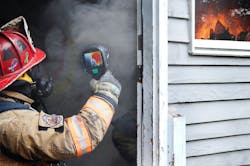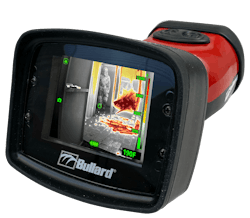Firefighters who use thermal imaging cameras (TICs) on the fireground should be aware of the numerous important TIC attributes that are critical to their success. One of the most important attributes is the application mode, or color palette, that’s selected for use. Often, our first impression of an incident is how we make the most important decisions. The choice of color palette can enhance or detract from those decisions.
NFPA’s change
For the past couple of decades, many firefighters carelessly have relied on the spot temperature indicator to evaluate the conditions that are within the TIC’s view. The latest edition of NFPA 1801: Standard for Thermal Imagers for the Fire Service (2021 edition) amends previous wording to help to curtail this behavior. The new wording removes the spot temperature from the TIC in the TI Basic mode. (TI Basic is the default mode that a TIC starts in.) Some firefighters questioned its removal. Some even asked how they were to measure heat without it. This is where the color palette that’s utilized by a TIC becomes important.
Note: The color palette isn’t the only way to identify heat. Firefighters also should pay close attention to moving grayscale convection currents that are passing through the environment. The location of these comparative to the height of the compartment and their speed are very important to identifying increasingly dangerous thermal conditions.
Color palette differences
All TICs utilize a system of colors to provide a relative measurement of heat. The majority of these fire service palettes span 200 degrees F or hotter per color. The temperature span of TI Basic color palettes of numerous manufacturers vary. That said, on the fireground, we don’t need the ability to gain an exact temperature measurement. The environment in which we operate doesn’t allow for that to be a practical assessment either. We merely must be able to identify the severity of the conditions and to adjust our actions to match.
NFPA 1801 indicates that fire service TICs shall use grayscale followed by yellow, orange and red in that ascending order. This implies that yellow is used for the least-severe thermal area and red for the most-severe area. (Most fire service TICs don’t show color beyond red.) NFPA 1801 also indicates that the color must be transparent, to still allow the operator to see within the color up to the point of saturation.
In the context of industrial thermography, the appearance of these colors would be called a “color alarm.” The intent of this is to draw attention to a temperature range (or area) that was identified as a problem and worthy of attention. The intent of these colors and their order in fire service TICs allow us to identify worsening conditions (or improving conditions) regardless of manufacturer or model of TIC.
The use of the colors is an overall benefit. However, there’s a possibility that the similarities haven’t been taken far enough. The ascending color palette doesn’t engage at the same time between all available TICs. Some fire service TICs begin to show color in TI Basic at around 300 degrees F. Some models won’t engage colorization until the temperature is more than 1,000 degrees F. This makes it imperative to understand the brand/type of model of TIC and how to properly use it.
The environment
Before diving deeper into the matter of when color engages on varying models of TICs, it’s important to look at the power that heat has on the environment, the firefighter and the victim.
Each piece of a firefighter’s protective ensemble is tested to specified limits. For example, not long ago, extensive testing was performed by the National Institute of Standards and Technology (NIST) on the facepiece lenses that were used at that time in the manufacture of SCBA. NIST noted that the average lens temperatures for cracks, bubbles and holes to form were approximately 356 degrees F, 392 degrees F and 518 degrees F, respectively. This piece of our ensemble was discovered to be the most vulnerable to heat damage from high-heat-flux, rapidly growing fire conditions. These problems begin to happen when the temperatures in the environment are within the range that’s associated with a thermal Class III environment (320 degrees F–500 degrees F) per NIST. The failure of our PPE is preventable in the overwhelming majority of circumstances through the identification of increased and dangerous levels of heat.
Our operating environment on the interior of a residential structure is affected greatly by heat. If this weren’t the case, fires wouldn’t be nearly as destructive as they are. It’s well known that the heat release rate is greater and ignition temperatures are lower for widely used synthetic materials in today’s homes. The threshold between a couch absorbing heat from the atmosphere and adding to the fire problem is lower than it ever has been. Identifying potential fuels that are being consumed by the fire’s heat can allow us to prevent further fire spread that might end up being behind our advance.
Lastly, but also most importantly, is the effect that heat has on our victims. Although all of our protective ensemble has thermal limits, citizens who are trapped in this environment have no protection. These individuals will begin to feel pain from the heat at approximately 113 degrees F. Human skin is destroyed after brief exposure to temperatures greater than 162 degrees F. Many might say that the level of heat that’s considered to be dangerous is a matter of perspective. However, the perspective that should concern us most is the one of those unprotected victims who are within the fire environment.
Yellow, orange & red
Currently, the color palettes that are available to the fire service engage yellow beginning at a point between 300 degrees F–500 degrees F. Materials presenting this color are being added to the fire’s fuel load actively. Even organic materials at these temperatures reach their ignition temperatures, much less their synthetic counterparts that are referenced above. If yellow has consumed a space completely, particularly in the lower areas, potential victims already are in grave danger, and we should work actively to cool these spaces.
The orange in most color palettes starts to show up between approximately 600 degrees F–800 degrees F, depending on the TIC that’s used. We should view orange of this temperature range as a warning of rapidly developing fire behavior. This color falls completely inside a thermal Class IV environment per NIST, which sets the standard for the thermal environments in which firefighting electronic equipment should be used. In this environment, our PPE and equipment is expected to maintain operation for a maximum of only one minute.
When red begins to overtake the image on the TIC, we should look to separate ourselves from the environment. This is an untenable environment, as our gear will provide limited protection for seconds. An area that’s saturated with red is approximately more than 800 degrees F. Our goal should be to cool these areas long before we find ourselves in them.
‘Apparent temperature’
The color palette of a TIC is a necessary attribute to understand and apply while under the stressors of the fireground. The temperature ranges in reference to color that are discussed in this article are wide approximations, because each manufacturer’s palette will vary. Although NFPA 1801 sets the colors and their order, it doesn’t set specified temperatures. It’s important to note that these temperatures are “apparent temperatures,” which are uncompensated temperature measurements, or estimates. Firefighters should learn to use the palette to quickly identify the environment in which they operate and to influence their tactics on the fireground.
Product Spotlight
Thermal Imagers
To improve the user experience, Teledyne FLIR’s enhanced K-Series includes improved clarity and contrast, to boost visibility, particularly in low-contrast scenes, so first responder missions are safer and more efficient. Heightened visibility prevents distortion and improves situational awareness. The TICs provide better identification of unstable floor areas, doors, openings and hidden compartments and faster detection and incident resolution.
TIC Training
Insight Training is a thermography-certified fire service training company that offers fire training on all fire service thermal imaging cameras worldwide. The company’s courses are credentialed and peer reviewed, and it offers the world’s first collegiate thermography-based program through Western Kentucky University, which is peer reviewed by Kentucky Thermal Institute.
INSIGHTTRAININGLLC.COM/COURSES
Thermal Imagers
The XT Series thermal imagers that are available from Bullard offer high performance and features that help to empower firefighters for confident decision-making on the fireground.
You can experience the TICs for yourself under live fire conditions at the FDIC TI Tailgate at the company’s stand (Booth 19021).
About the Author

Joey Baxa
Joey Baxa has been a firefighter for 15 years. He currently holds the rank of captain with the Buckhannon, WV, Fire Department. Baxa also is an instructor with Insight Training LLC and is an adjunct instructor with West Virginia University Fire Service Extension.




